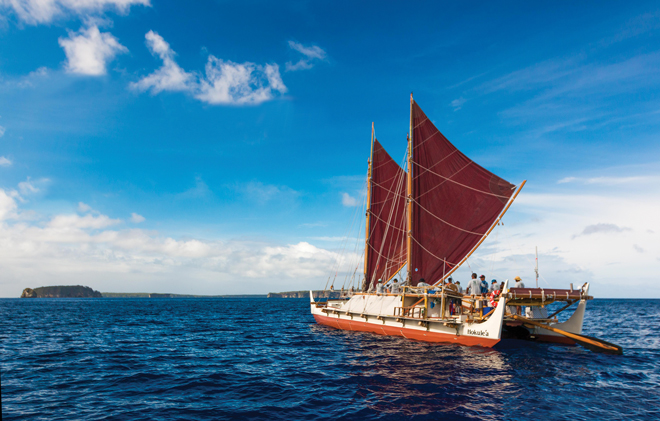
On 17 June 2017, the Polynesian voyaging canoe Hokule’a sailed into her homeport of Honolulu, Hawaii. It was the completion of a 47,000-mile, three-and-a-half year voyage, around the world entirely under sail. The 12.5-ton, 62-foot double-hulled vessel is a replica of the vessels used for nearly two millennia to journey across vast stretches of the Pacific. In Hawaiian, Hokule’a means “Star of Gladness,” referring to the zenith star Arcturus.
A crowd estimated at 50,000 greeted Hokule’a’s arrival. It was a proud time for Hawaiians, whose ancestors had employed “wayfinding” to navigate across 10 million square miles of the Pacific. Though this art was practiced for nearly 2000 years, by the 20th Century it was extinct in Polynesia.
Using only wayfinding, the Hokule’a’s crew navigated the entire voyage without charts, sextants, compasses, global positioning system, or other devices used by modern navigators. Instead, they used observations of the natural world around the canoe by reading the sea surface, motions of the waves and swells, and—most importantly—the paths of the stars and the sun. When closer to land they also were guided by cloud patterns and land-based marine bird life. In the mid-1970’s, wayfinding knowledge was nearly extinct—only practiced in Micronesia by a few mariners. A handful of them agreed to teach the ancient ways, and today a growing number of Polynesians are qualified master wayfinders.
The Hokule’a is no newcomer to wayfinding voyages. She was built in March 1975 at the ancient royal meeting site of Haikipu’u-Kualoa on Oahu. Before construction began, there was a considerable search throughout the Pacific Islands to find craftsman skilled in the ancient arts of building a voyaging canoe. In New Zealand, Maori shipwrights constructed a few smaller canoes, which ultimately led to construction of the Hokule’a, the first such canoe built in 600 years.
In May 1976, the canoe departed on a 2,800 mile trip to Tahiti. This represented a remarkable expansion of known wayfinding techniques of the time. Memorizing the skies above the Hawaiian Islands was not enough, now those en route to French Polynesia had to be mastered as well. The crew of the Hokule’a knew such a trip was possible; the first Hawaiian settlers did it around the year 1200.
Between the first Tahiti voyage and 2007, the Hokule’a made nine more long training voyages around the Pacific area. The longest was to Japan. An escort vessel accompanied each trip for safety.
The Hokule’a’s typical crew size was 12-13 people. Most were students, primarily from Hawaii, who had successfully completed a rigorous shoreside training program before going to sea. On board, instruction continued in navigation, seamanship, and the seagoing culture of Polynesia. More than 245 volunteer crewmembers sailed various legs of the round-the-world voyage.
The circumnavigation began on 18 May 2014 when she sailed away from Honolulu. For most of the trip, the Hokule’a was accompanied by the 72-foot Hikianalia, a New Zealand-built, modern voyaging canoe. Launched in 2012, the Hikianalia had a contemporary navigation suite on board and electric propulsion from solar cells.
Their voyage track was generally to the west, and they made 150 port calls in 23 nations, including Australia, Indonesia, South Africa, Brazil, the United States, and Canada. After passing through the Panama Canal they sailed back to Hawaii. During the voyage, tens of thousands of people became acquainted with the Hokule’a and her centuries-old wayfinding skills.
The Hawaii-based Polynesian Voyaging Society (PVS), founded in 1975, planned and executed all of the Hokule’a’s voyages. It was created to promote rediscovery of, and education about, the ancient Polynesian seagoing cultures. During the circumnavigation, more than 200 educators were involved in the operations of the Hokule’a and Hikianalia, both PVS school ships.
The Hokule’a’s round-the-world voyage helped restore pride to the people of Oceania, whose ancestors were great open-ocean voyagers centuries before Europeans made blue sea voyages out of sight of land.
Don Walsh, a marine consultant, is a retired naval officer and oceanographer. In 1960, he was one of the first two men to reach the deepest point in the ocean—Challenger Deep—on board the submersible Trieste.


